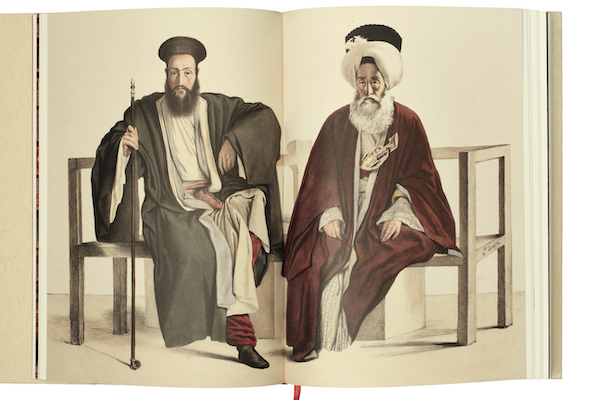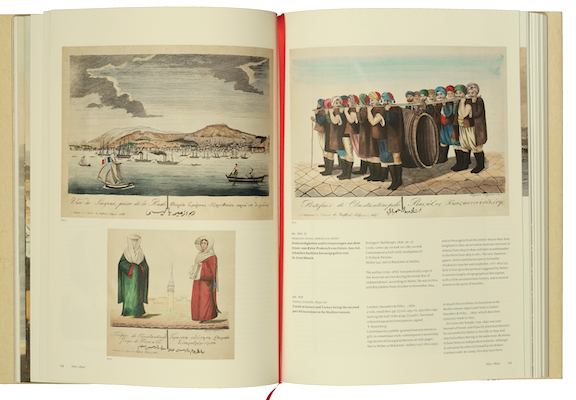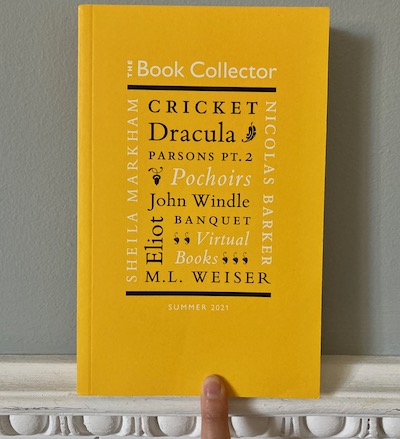The most obvious comparisons [of the Koç library] will be with the Blackmer and Atabey collections, and there are many books here from those distinguished sources, but Mr Koç’s library now exceeds those in both breadth and depth. For most of the 20th century it must have seemed impossible that another library could be formed comparable to that of Gennadios; now, however, one begins to wonder.
Angus O’Neill, preface to The Ömer Koç Collection. Impressions of Istanbul: Voyage to Constantinople
· · · · · · · · · · · · · · · · · · · · · · · · · ·
The following review was written by Type & Forme’s Anke Timmermann. It was first published in The Book Collector, Summer 2021.
The Ömer Koç Collection. Impressions of Istanbul: Voyage to Constantinople. Volume I: 1493-1820 [Volume II: 1821-1850]. Text by Angus O’Neill
(Vehbi Koç Foundation, 2014 and 2020. 367pp and 296pp, illustrations, £245 each)
This is certainly that part of the Universe above all others, where the eye most deliciously feeds itself with a prospect every way delightful. There is nothing can be beheld, nor conceiv’d more charming to the sight, than this approach to Constantinople.
Guillaume Joseph Grelot, A Late Voyage to Constantinople… (London, 1683)

In the late seventeenth century Guillaume Grelot travelled to Constantinople to document its monuments. The city’s most famous mosque, the Hagia Sofia, proved to be a challenge, but with the help of persuasion and bribery Grelot finally managed to obtain entry. ‘[I]n addition to his sketching materials, he took a loaf of bread, a bottle of wine and a Bologna sausage to fortify himself during the day’ – he was, indeed, ‘lucky not to have been apprehended’ (no. 75).
With the publication of the first two volumes of the catalogue Impressions of Istanbul: Voyage to Constantinoplebibliophile armchair travellers now not only have the opportunity to learn about the many accounts which told the Western world about the Istanbul of the past, its people, customs, culture, and beauty, but also to step virtually into the astounding library into which they were gathered over the course of several decades by Ömer Koç, the noted Turkish philanthropist and patron of the arts. ‘The most obvious comparisons [of the Koç library] will be with the Blackmer and Atabey collections, and there are many books here from those distinguished sources, but Mr Koç’s library now exceeds those in both breadth and depth’, writes the cataloguer, Angus O’Neill, in his preface. ‘For most of the 20th century it must have seemed impossible that another library could be formed comparable to that of Gennadios; now, however, one begins to wonder’. These first two volumes of the catalogue satisfyingly reflect the library’s significance in their imposing folio format, presenting 456 works (some in multiple editions) dating from the fifteenth to the mid-nineteenth centuries with bibliographic detail, informative descriptions, and a wealth of colour illustrations. Each volume ends with a bibliography and index.

Volume 1 (which includes Norman Stone’s introduction to the collection) begins within living memory of the Ottoman Turkish conquest of Constantinople of 1453 with a landmark incunable: the first edition of Hartmann Schedel’s Liber chronicarum (commonly known as the ‘Nuremberg chronicle’) of 1493, ‘one of the masterpieces of 15th-century graphic art’ with its famous double-page woodcut view of Constantinople. The catalogue then continues chronologically with works from the following three-and-a-quarter centuries, to the eve of the Greek War of Independence. For the 16th century, as the perpetual stream of international travellers makes itself known in print, there are also unique manuscripts, among them a charming album of drawings from ca 1595 showing, among other things, an Ottoman wedding procession and European monks, the latter ‘probably due to the presence in Constantinople of emissaries from various French and German religious orders, who would have travelled to the Levant to negotiate protection for pilgrims’ (no. 24). The album is ‘typical of the productions of the Constantinople painting workshops, where merchants, diplomats and other rich travellers visiting the city could choose their own images of Ottoman costumes or figures’, which in turn were often based on Nicolas de Nicolay’s originals from his famous work Les quatre premiers livres des navigations et peregrinations orientales… (Lyon, 1568, second impression, no. 18).
Over time the accounts of the city on the Bosporus appear in a multitude of languages, and are produced in Germany, Italy, the low countries, England, France, and beyond. O’Neill observes: ‘One subject that has particularly interested me has been the worldwide spread of information (and misinformation) on the Ottoman Empire in general and Istanbul in particular. I have, therefore, attempted to trace the transmission of texts (and images) by listing foreign editions and translations, many of which are surprising, and by considering the books as unique copies, with provenances which often stimulate the imagination. […] [I]t is good to know that one of the books in this collection (Pierre Gilles’ De Bosporo Thracio…, no. 17) once belonged to a 16th-century Archbishop and Prince-Elector of Cologne, one of the foremost Christian allies of Süleyman the Magnificent’ (preface). And thus volume 1 continues through to 1820.
The fact that volume 2 – ending just before the Crimean War and thus covering just three decades – roughly matches its companion in scope and heft will give some impression of how comprehensively this period is represented in the Koç library. The relevant books reinforce the impression that the entire world, be they pilgrims, merchants, explorers, celebrities, or nobles, passed through Istanbul at one point or another. Here we have the Voyages and travels of Her Majesty, Caroline, queen of Great Britain… By one of Her Majesty’s suite (commonly assumed to be her maid, Louise Demont), whose account of Constantinople ‘is devoid of original observations or anecdote’ (London, 1821, no. 220). There is Carl Otto Ludwig von Arnim, who moved in diplomatic and aristocratic circles and whose impressions of Istanbul life in court circles include ‘accounts of the theatrical entertainments set up by the French wife of Bartholomäus von Stürmer, the Austrian ambassador to the Porte’ (Flüchtige Bemerkungen eines Flüchtig-Reisenden… Vermehrte Ausgabe (Berlin, 1841), no. 370). There is also the first edition of Lord Byron’s Private Correspondence, edited by Robert Charles Dallas, the manuscript title of which explains that the ‘following sheets are the whole that were printed when an Injunction was obtained from the Court of Chancery at the suit of Messrs Hobhouse & Hanson Executors of the late Lord Byron to restrain the publication of the work on the 7th July 1824’ (London, 1824; no. 235); Dallas’ son eventually managed to publish the book in Paris with Galignani (1825, no. 235a), and notably, neither edition is present in the catalogues of the Gennadius, Blackmer, or Atabey libraries. Even through this brief conspectus, readers will appreciate the scope of the treasures to be found within Mr Koç’s library.
Particularly striking are the numerous beautiful and large-scale reproductions of plates that show Istanbul through the eyes of the historic traveller and benefit from Impressions of Istanbul: Voyage to Constantinople’s large format. Illustrated here is one of the 40 lithographed plates from Louis Dupré’s Voyage [à] Athènes et [à] Constantinople, ou Collection de portrais, de vues et de costumes grecs et ottomans… of 1825 (no. 243), and – as if the double-page plates of this quality were not quite enough – there are also five magnificent fold-out plates from J. Pitman’s Panorama of Constantinople and its environs from Scutari (London, ca 1831, no. 284). The high production values of the volumes do justice to O’Neill’s scholarly and detailed catalogue, which often draws out previously overlooked, under-considered, or, indeed, unknown aspects of the books. The two published volumes of Impressions of Istanbul: Voyage to Constantinopleare a necessary and worthy companion to Leonora Navari’s landmark catalogues of the Blackmer and Atabey collections, and can be unreservedly commended to the libraries of all interested in the subject.
Both volumes of Impressions of Istanbul: Voyage to Constantinople are available from Cornucopia (www.cornucopia.net).
· · · · · · · · · · · · · · · · · · · · · · · · · ·

The complete Summer 2021 issue of The Book Collector is now available!
If you enjoyed this review and would like to read more about all things bibliophile, it may be worth exploring a subscription.

